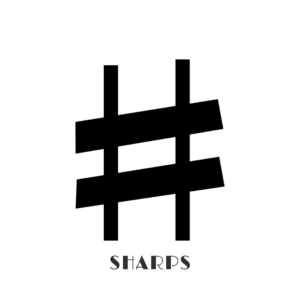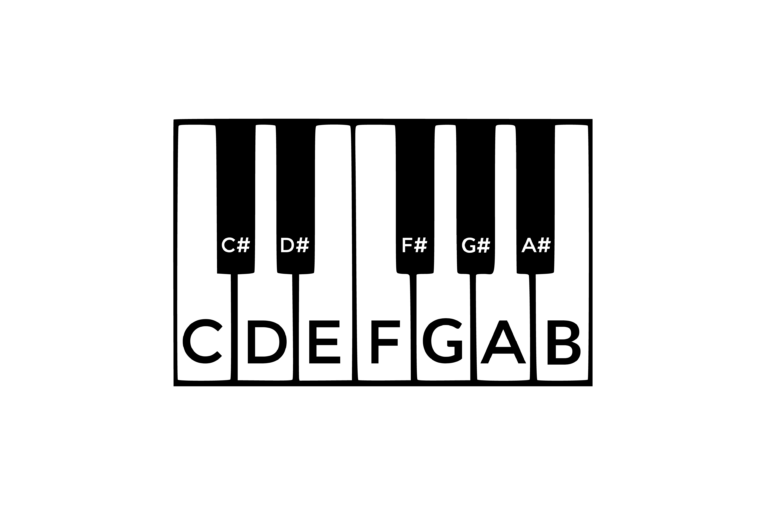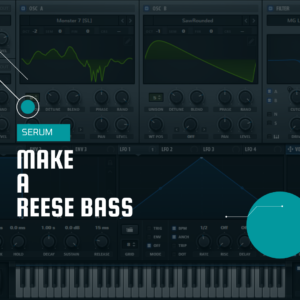Audio
When you have memorized the white keys, it is important to understand the concept of the black keys and their relation to the white key notes.
These can be tricky to understand at first. We will learn without being too technical.
*The reason it may be hard to understand is because the black keys can be referenced as a sharp or flat.
Make sure to understand why a sharp is a sharp before moving on to flats.
What is a Sharp?
In music, a sharp is when you go up in pitch. The easy way I remember this is by seeing it as “sharpening” the sound.

A sharp is identified by a hashtag sign: ♯.
Sharps relation to the white keys.
We went over the white keys, they contained 7 letters of the alphabet.
The black keys contain the same letters, with a sharp symbol.

New Term.
Semitone [the smallest interval used in classical Western music, equal to a twelfth of an octave or half a tone.]
See video below showing you a semitone movement.
Example: from C, a semitone or half-step up to the right, giving you C sharp.
Going to the right is “sharpening” the sound.
Learn the Sharp.
If you take a look at the image above.
The black keys represent these sharps.
An easy way to learn the sharps is to look at the white note directly to the left of the sharp you want to play.
From left to right,
The first black key, a semitone to the right of the C key is C♯.
The second black key, a semitone to the right of the D key is D♯.
The third black key, a semitone to the right of the F key is F♯.
The fourth black key, a semitone to the right of the G key is G♯.
And lastly the fifth key, a semitone to the right of the A key is A♯.
Notes without sharps.
The only keys without any black keys next to them are E and B. These two notes don’t have sharps.
So if you go one semitone to the right from E, you will be landing on F.
And from B if you go a note or semitone to the right you will land on C.
As you can see on the piano key image above. No black keys, no sharps.
Last, Important Note.
Music is complex, people interpret it in many ways.
Although, the notes E and B don’t have sharps…
If you ever hear someone reference E sharp… just know they are talking about an F note. Vice versa with C being B sharp.
What's next?
Good job learning sharps! Memorize them.
We will learn about FLATS in the next post.
Quick Review
In music notation, a sharp is when you go up in pitch. The easy way I remember this is by seeing it as “sharpening” the sound.
A Sharp is an Accidental.
Accidental: a sign indicating a momentary departure from the key signature by raising or lowering a note.
The black keys will contain letters with a sharp symbol.
There are 5 sharps: C♯, D♯, F♯, G♯, A♯.
Going notes to the right of the piano, give you sharps.
Unlocking the Black Keys
"If the white keys are the basics, the black keys are the spicy extra." In this lesson, we discover the world of Sharps (#) and locate the five mysterious black keys on the piano.
What Exactly Is a Sharp?
Before finding notes, we need to understand the concept. In simple terms: Sharpening a note means raising its pitch.
The # Symbol (Accidental)
It looks like a hashtag, but in music, this symbol is the Sharp. It acts as an "Accidental," temporarily altering a note's pitch outside of the key signature.
You'll see this symbol in chord names (C#m) and music software.
Finding the Five Sharps
The black keys are simply "Western music's sharps." Finding them is easy: Just look to the right of the white key.
The black key to the immediate right of C is C Sharp.
The Semitone Step
This movement—from a white key to its neighbor black key—is called a Semitone (or Half Step). It is the smallest interval in Western music. Think of it like climbing a ladder one tiny rung at a time.
The Curious Case of E and B
You'll notice there is no black key between E & F and B & C. Does that mean E# doesn't exist?
Technically, E# does exist in music theory, but on a piano, E# is just the F key. Similarly, B# is just C. It's a "spelling" rule we use in specific keys, but for now, just know that the black keys are grouped in 2s and 3s.
Why It Matters
Sharps aren't just theory; they are tools. Knowing them allows you to:
- Read complex chord charts (like C#m).
- Understand MIDI notes in your DAW.
- Add "color" and "brightness" to your melodies.
Quick Review
- Sharp (#): Raises a note's pitch by one semitone.
- Semitone: The smallest step (White -> Neighbor Black).
- Location: Always to the RIGHT of the white key.
- The Squad: C#, D#, F#, G#, A#.
Your Musical Adventure Continues!
You've unlocked the Black Keys! These "spicy" notes open up a whole new world of scales and emotions.
But wait... if Sharps go UP, what happens when we go DOWN? That's where the flats come in.
📜 Side Quest Board
Wait, what about Flats? And what is a "Natural"? Uncover the full Accidental Squad.
Learn about Sharps, Flats, and Naturals before entering the challenge.
SYLBiT: Sharp Shooter
Training Manual
• Sharp ID: Finds the target black key (e.g. Find C#3).
• Sharpen It: We highlight a white note (e.g. C). You click the SHARP version (Right Black Key).




